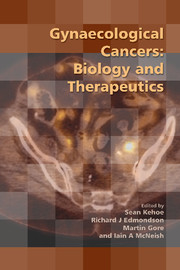Book contents
- Frontmatter
- Contents
- Participants
- Declarations of personal interest
- Preface
- SECTION 1 BIOLOGY OF GYNAECOLOGICAL CANCERS: OUR CURRENT UNDERSTANDING
- SECTION 2 THE TRANSLATION OF BIOLOGY TO THE CLINIC
- SECTION 3 IMAGING AND THERAPY: STATE OF THE ART
- 8 The role of robotics and the future
- 9 ‘Ultra-radical’ surgery in advanced ovarian cancer
- 10 Antivascular therapy in gynaecological cancers
- 11 Oncolytic viral gene therapy in ovarian cancer
- 12 Endometrial cancer: what have the clinical trials taught us?
- 13 Targeting therapies in cancer: opportunities in ovarian cancer
- 14 Functional imaging: from tumour biology to the clinic
- SECTION 4 WHAT QUESTIONS ARE BEING ASKED BY CURRENT CLINICAL TRIALS?
- SECTION 5 CONSENSUS VIEWS
- Index
10 - Antivascular therapy in gynaecological cancers
from SECTION 3 - IMAGING AND THERAPY: STATE OF THE ART
Published online by Cambridge University Press: 05 February 2014
- Frontmatter
- Contents
- Participants
- Declarations of personal interest
- Preface
- SECTION 1 BIOLOGY OF GYNAECOLOGICAL CANCERS: OUR CURRENT UNDERSTANDING
- SECTION 2 THE TRANSLATION OF BIOLOGY TO THE CLINIC
- SECTION 3 IMAGING AND THERAPY: STATE OF THE ART
- 8 The role of robotics and the future
- 9 ‘Ultra-radical’ surgery in advanced ovarian cancer
- 10 Antivascular therapy in gynaecological cancers
- 11 Oncolytic viral gene therapy in ovarian cancer
- 12 Endometrial cancer: what have the clinical trials taught us?
- 13 Targeting therapies in cancer: opportunities in ovarian cancer
- 14 Functional imaging: from tumour biology to the clinic
- SECTION 4 WHAT QUESTIONS ARE BEING ASKED BY CURRENT CLINICAL TRIALS?
- SECTION 5 CONSENSUS VIEWS
- Index
Summary
The great majority of women with advanced ovarian cancer will relapse and die from their disease. There is therefore a great need for new agents that can extend remission and prolong survival. One approach is to introduce agents that target the vasculature that maintains a tumour's ability to survive and grow. These can be divided into agents that act against established blood vessels (vascular disrupting agents or VDAs) or inhibit the formation of new blood vessels (anti-angiogenic drugs). Angiogenesis inhibitors are considered to be cytostatic in nature, in contrast to VDAs, which are thought to be cytotoxic, but there is considerable overlap between the two groups, with agents classified according to their primary site of action (Box 10.1).
Angiogenesis is under dynamic regulation by stimulatory pro-angiogenic factors released by tumour and host cells, such as vascular endothelial growth factor (VEGF), platelet-derived growth factor (PDGF), basic fibroblast growth factor (bFGF), interleukin 8 (IL-8), matrix metalloproteinases (MMPs) and inhibitory anti-angiogenic factors (tumour necrosis factor [TNF], 5-HT, angiostatin, endostatin). Diffusion of nutrients and oxygen from nearby capillaries beyond a tumour size of 2 mm is insufficient to sustain cell function. An imbalance of pro- and anti-angiogenic factors stimulates an angiogenic switch so that the tumour develops an angiogenic phenotype to grow and metastasise. Several process are thereafter involved, such as endothelial cell proliferation, proteolytic degradation of the extracellular matrix and migration of endothelial cells, leading to the formation of a functioning vessel with a lumen.
Keywords
- Type
- Chapter
- Information
- Gynaecological CancersBiology and Therapeutics, pp. 121 - 138Publisher: Cambridge University PressPrint publication year: 2011



